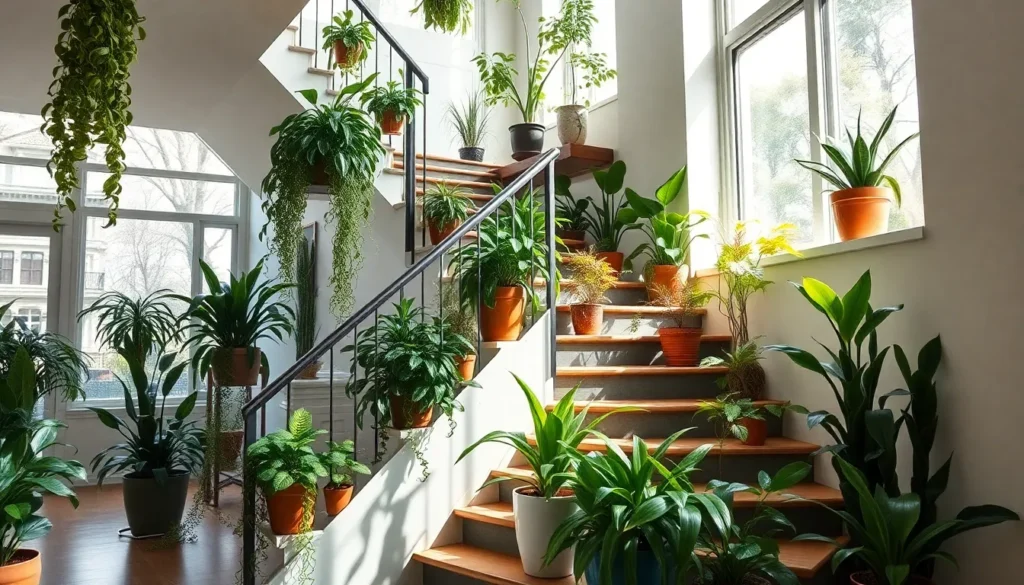We’ve all walked past those stunning staircases adorned with lush greenery and wondered how to recreate that magical indoor garden effect. Indoor stair plants transform ordinary staircases into breathtaking focal points that breathe life into our homes while maximizing unused vertical space.
Transform your staircase from a simple pathway into a living masterpiece that’ll make your guests stop and stare. Whether you’re working with a grand staircase or a compact set of steps, we’ll show you how to select the perfect plants that thrive in stairway conditions while creating visual drama that elevates your entire home’s aesthetic.
From trailing pothos cascading down bannisters to architectural snake plants standing guard on landings, the possibilities are endless. We’ll guide you through everything from low-light stairway plants to creative display techniques that’ll turn your stairs into the showstopper your home deserves.
Transform Your Indoor Staircase Into a Green Oasis With Strategic Plant Placement
Strategic positioning of plants on indoor staircases creates an immersive botanical experience that flows naturally through your vertical space. We’ve discovered that successful staircase plant arrangements depend on understanding light patterns, traffic flow, and visual balance throughout the entire stairway structure.
Consider Light Conditions at Different Stair Levels
Upper stair areas typically receive the most natural light from windows or skylights, making them perfect spots for medium to bright light plants like fiddle leaf figs or monstera deliciosa. Middle sections often experience filtered or indirect lighting conditions that work beautifully with pothos varieties, philodendrons, and prayer plants. Lower stair zones usually have the least amount of natural illumination, requiring us to select low light champions such as ZZ plants, cast iron plants, or Chinese evergreens.
Map Your Traffic Patterns Before Plant Placement
Heavy foot traffic areas need plants positioned away from the walking path to prevent accidental damage and ensure safety for family members. We recommend placing larger floor plants like snake plants or rubber trees in corners where stairs meet landings, creating natural resting points for the eye. Hanging planters work exceptionally well above head height along stairway walls, allowing trailing plants like string of hearts or ivy to cascade without interfering with movement.
Create Visual Rhythm Through Plant Heights and Textures
Alternating plant heights creates an captivating visual journey as people move up or down the staircase, preventing the arrangement from appearing monotonous or cluttered. Tall architectural plants like dracaena or bamboo palm serve as anchor points, while medium sized plants such as peace lilies or Boston ferns fill middle spaces effectively. Small accent plants including succulents, air plants, or small trailing varieties add delicate finishing touches to shelving units or window sills.
Balance Plant Colors and Foliage Patterns
Deep green foliage plants provide a calming backdrop that complements most interior color schemes while creating sophisticated botanical displays throughout the stairway. Variegated plants with cream, yellow, or white markings add brightness to darker stair areas and create interesting focal points that draw attention upward. Plants with unique leaf shapes like monstera with their split leaves or calathea with their decorative patterns introduce visual interest without overwhelming the space.
Choose Low-Light Plants That Thrive in Stairwell Environments
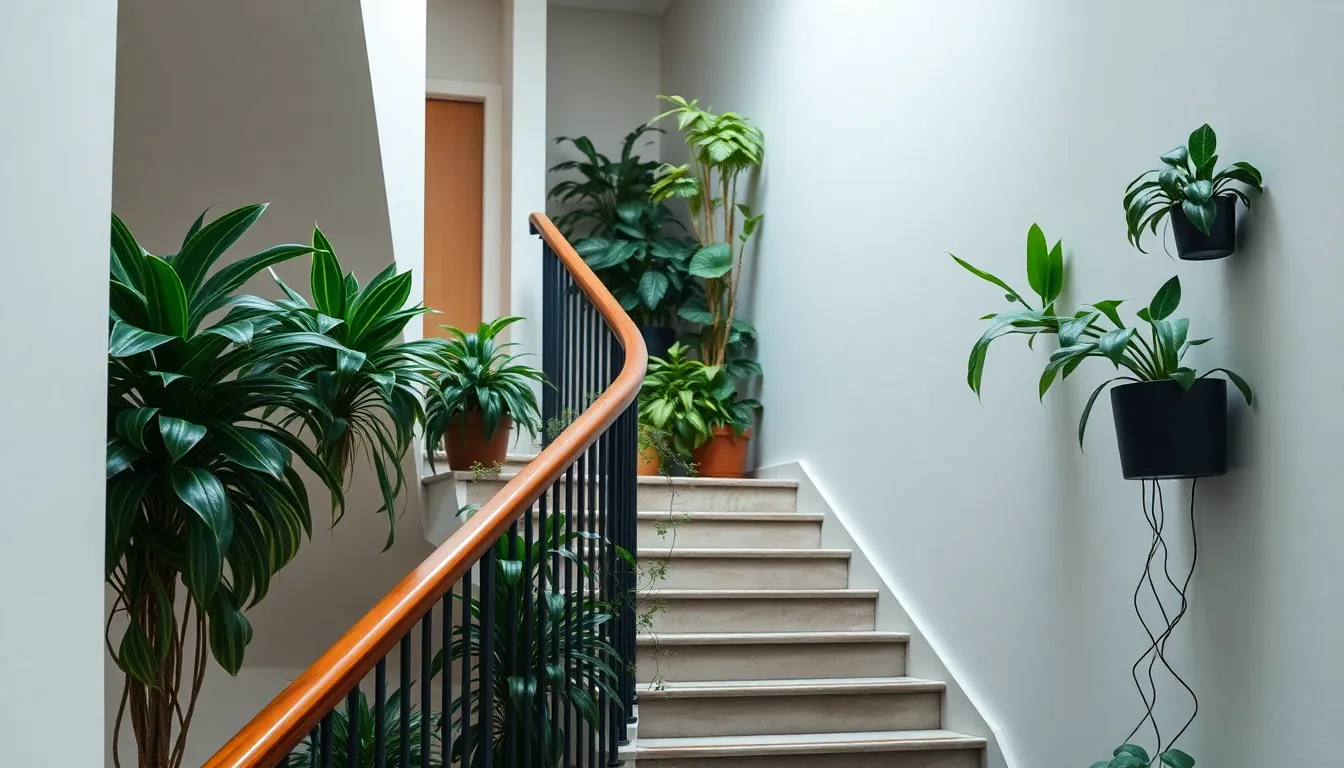
Stairwells present unique challenges with their typically dim lighting and limited space, making plant selection crucial for success. We’ll focus on varieties that not only tolerate these conditions but actually flourish in them.
Snake Plants for Minimal Maintenance
Snake plants stand out as the ultimate low maintenance choice for stairwell environments. These resilient beauties require very little water and thrive in low light conditions that would challenge most other houseplants. Their upright, sword like leaves create striking vertical elements that complement narrow stair spaces perfectly.
Air purifying qualities make snake plants even more valuable for indoor stairwells where ventilation might be limited. We love how their architectural form adds modern sophistication without demanding constant attention or frequent watering schedules.
Pothos Varieties for Trailing Beauty
Pothos plants excel in staircase settings because their trailing nature creates stunning cascading effects along railings and shelves. These adaptable climbers tolerate low light conditions while handling irregular watering with remarkable resilience. Variegated leaves bring vibrant splashes of green that brighten even the dimmest stairwell corners.
Golden pothos and marble queen varieties offer different color patterns to match your decor preferences. We recommend placing them on upper landings where their vines can gracefully drape downward, creating natural green curtains that transform ordinary stairs into botanical showcases.
ZZ Plants for Dark Corners
ZZ plants dominate as the champions of extremely low light environments, making them perfect for the darkest stairwell corners. Known for enduring both low light and drought conditions, these robust plants maintain their glossy, waxy leaves regardless of neglect. Their smooth foliage reflects available light, helping brighten shadowy spaces naturally.
Zamioculcas zamiifolia requires minimal care while providing maximum visual impact in challenging locations. We find them particularly effective in basement stairwells or interior stairs without windows, where other plants simply can’t survive the limited light conditions.
| Plant Type | Light Requirement | Key Features | Stairwell Benefits |
|---|---|---|---|
| Snake Plant | Low light | Vertical growth, minimal water needs | Fits narrow spaces, air purifying |
| Pothos | Low to medium light | Trailing vines, variegated foliage | Beautiful cascading effect |
| ZZ Plant | Very low light | Glossy leaves, drought tolerant | Perfect for darkest corners |
Select Appropriate Containers for Stair Safety and Style
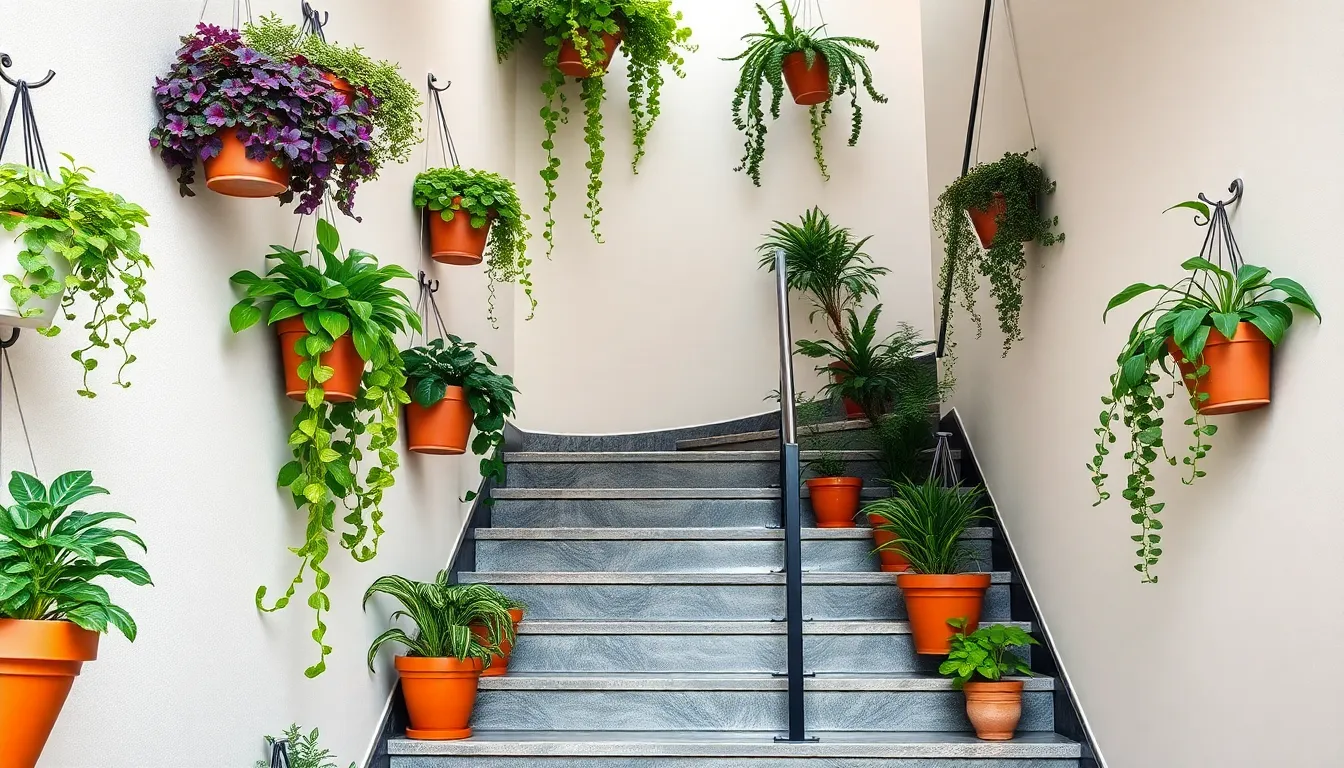
Once we’ve chosen our perfect stair plants, selecting the right containers becomes crucial for both safety and aesthetic appeal. The container choice directly impacts the overall success of our indoor stair garden design.
Wall-Mounted Planters to Save Floor Space
Wall-mounted planters offer the perfect solution for keeping our stair steps completely clear while adding greenery to vertical surfaces. We can install these planters along stair railings or adjacent walls to maximize our growing space without creating trip hazards.
Narrow staircases benefit enormously from this approach since we’re utilizing vertical space rather than competing for limited floor area. Half landings provide excellent mounting opportunities where we can create stunning plant displays without obstructing foot traffic.
Installation along handrail walls allows us to position plants at eye level for maximum visual impact while maintaining easy watering access. We recommend choosing planters with built-in drainage systems to protect wall surfaces from water damage.
Weighted Pots to Prevent Tipping
Weighted containers provide essential stability when we place plants directly on stair steps or landings. Lightweight plastic pots work best for safety reasons since they won’t cause serious injury if accidentally knocked over, unlike heavier ceramic or terracotta options.
Adding stones or gravel to the bottom of containers creates the necessary weight distribution to prevent tipping while maintaining manageable handling. We can achieve this balance by filling the bottom quarter of each pot with decorative river rocks before adding soil.
Wrought iron plant stands elevate containers safely while adding architectural interest to our stair design. These stands distribute weight evenly and reduce the risk of accidental displacement during daily foot traffic.
Container dimensions should align with our stair width measurements to ensure safe passage while maximizing plant display potential. We need to leave adequate clearance for comfortable navigation while showcasing our botanical selections effectively.
Hanging Baskets for Vertical Interest
Hanging baskets transform empty overhead space into cascading gardens that draw the eye upward through our stairwell. We position these containers to create dramatic trailing displays without interfering with head clearance or handrail functionality.
Secure mounting brackets become essential for safety since baskets must support both plant weight and regular watering additions. We recommend using heavy-duty ceiling hooks rated for at least twice the expected basket weight to ensure long-term stability.
Strategic placement along balustrades creates flowing botanical curtains that enhance the stairway’s architectural features. Multiple baskets at varying heights establish visual rhythm while maximizing our vertical growing space throughout the stairwell environment.
Drainage considerations require careful planning since water runoff from hanging baskets can create slip hazards on stair surfaces below. We solve this by using saucers or selecting baskets with integrated water collection systems to protect our stair materials.
Position Plants Strategically for Maximum Visual Impact
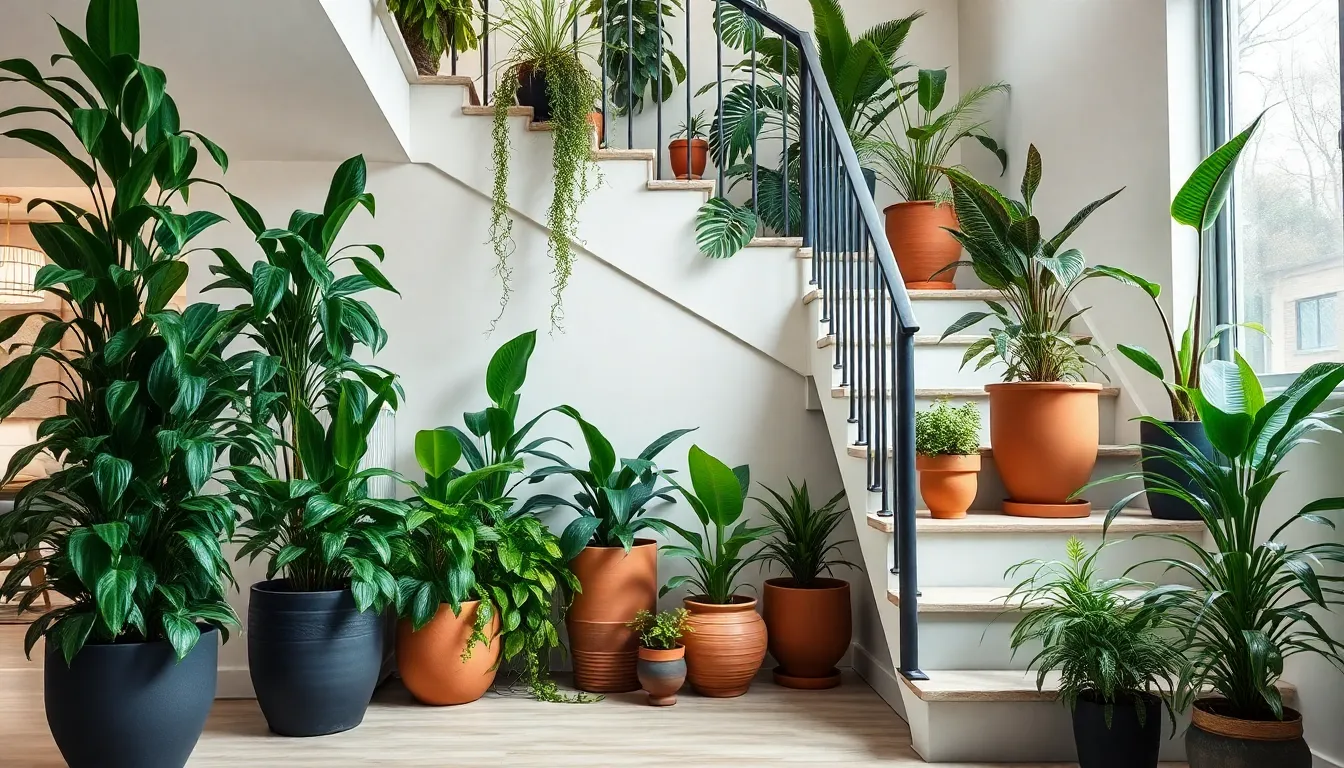
Placement makes all the difference when we’re transforming our indoor stairs into living showcases. Strategic positioning amplifies visual appeal while maintaining functionality throughout our stairway spaces.
Create Rhythm With Repeating Plant Arrangements
Repeating similar or matching plants at regular intervals establishes visual rhythm that guides the eye naturally up our staircase. We achieve this cohesive flow by grouping plants of the same species together on multiple steps or landings.
Matching planters create unity when we place identical snake plants on every third step. Consistent spacing between arrangements maintains the rhythmic pattern that makes our stairway feel intentionally designed.
Similar foliage colors work together to strengthen the visual connection between levels. We can alternate between two complementary plant varieties to add subtle variation while preserving the overall rhythmic effect.
Use Different Heights for Ever-changing Display
Different plant heights add layers and dimension that engage the eye vertically throughout our staircase display. We combine tall upright plants with shorter trailing varieties to create balanced movement and visual structure.
Tiered planters maximize our vertical space by accommodating multiple plants at varying elevations. Repurposed ladders serve as excellent plant stands that display greenery at different heights along our stairs.
Trailing plants like pothos cascade gracefully when positioned above upright specimens. We balance this ever-changing by mixing structured plants with flowing varieties that create natural movement down our stairway.
Focus on Landing Areas for Statement Pieces
Larger plants positioned on stair landings serve as focal points that anchor our entire botanical display. These statement pieces draw attention and provide visual weight that balances the lighter arrangements on individual steps.
Bold containers enhance the impact of our landing plants while complementing the overall stair design. We choose planters that contrast with our surroundings to make these focal points stand out dramatically.
Palms, ferns, and Schefflera thrive in naturally lit stair landings, making them ideal choices for our statement greenery. These substantial plants fill corner spaces effectively while creating impressive vertical presence that commands attention from both directions of our staircase.
Ensure Proper Lighting for Healthy Plant Growth
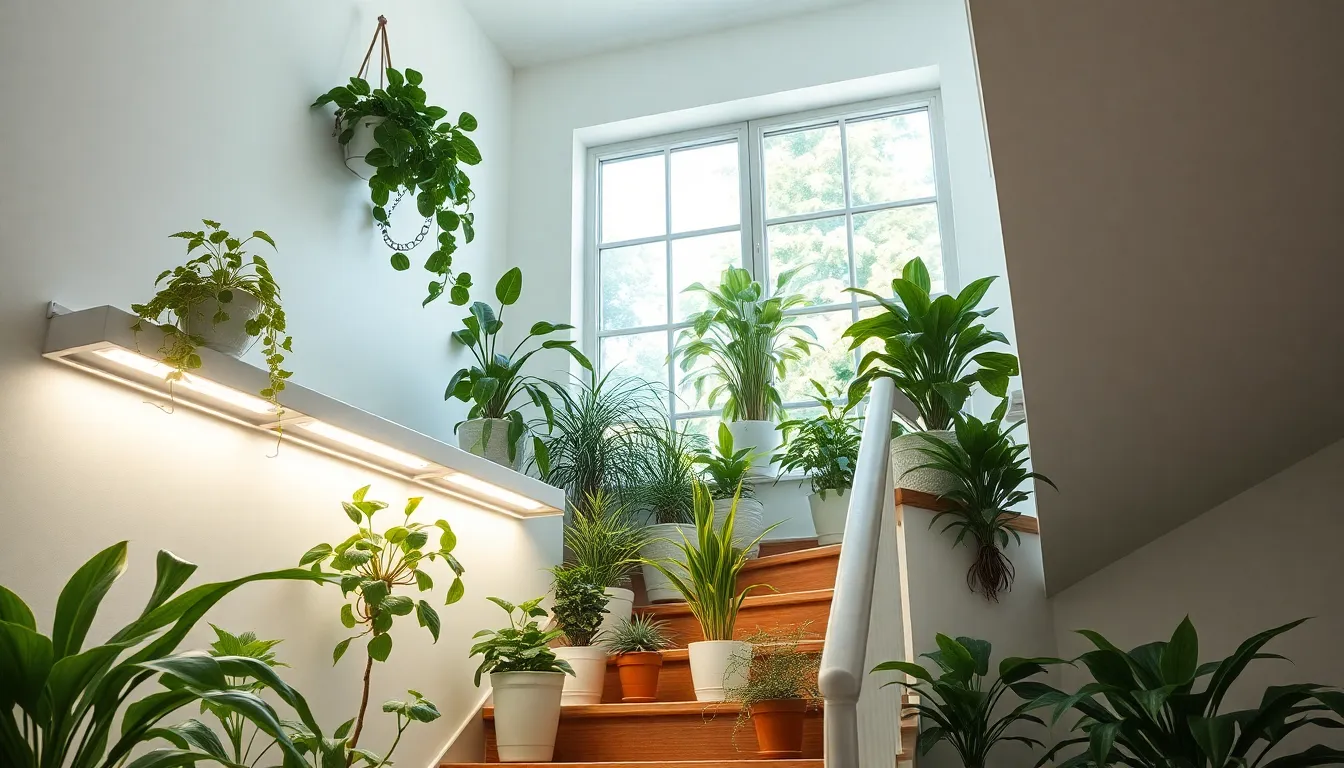
Most indoor staircases receive limited natural light, making proper lighting essential for plant health and photosynthesis. We’ll explore practical answers to overcome lighting challenges and create thriving stair gardens.
Install LED Grow Lights in Dark Stairwells
LED grow lights simulate sunlight when natural light isn’t available in darker stairwells. These lights provide the full spectrum plants need for photosynthesis and healthy growth without the heat buildup of traditional bulbs.
Installing LED strips along stair railings creates consistent lighting throughout the vertical space. Position lights 12-18 inches above plants to ensure optimal coverage while avoiding leaf burn. Modern LED systems consume minimal energy and last for years, making them cost-effective for continuous plant care.
Timer controls allow us to maintain consistent light schedules, typically 12-14 hours daily for most indoor plants. This automated approach ensures plants receive adequate light even when we’re away from home.
Maximize Natural Light From Windows
Windows near staircases provide valuable natural light that we can leverage for plant placement. Position plants in spots that receive indirect bright light to prevent leaf scorching while promoting healthy growth.
Mirrors strategically placed opposite windows can reflect and amplify natural light throughout the stairwell. This technique doubles the available light without additional electrical installations, particularly benefiting plants like pothos that flourish in bright indirect conditions.
Light-colored walls and surfaces help bounce existing natural light around the space. Painting darker stairwells in lighter shades creates a brighter environment that supports plant growth while improving the overall aesthetic.
Rotate Plants Regularly for Even Growth
Rotating plants every 1-2 weeks ensures all sides receive balanced light exposure. This practice prevents leggy growth and maintains symmetrical plant shapes that complement stair architecture.
Quarter turns work best for most plants, allowing each side to face the light source gradually. Plants naturally grow toward light, so regular rotation prevents them from leaning permanently in one direction.
Mark pot positions with small stickers to track rotation schedules easily. This simple system helps maintain consistent plant care routines and ensures no plant gets overlooked in our rotation schedule.
Maintain Safe Walkways While Decorating With Plants
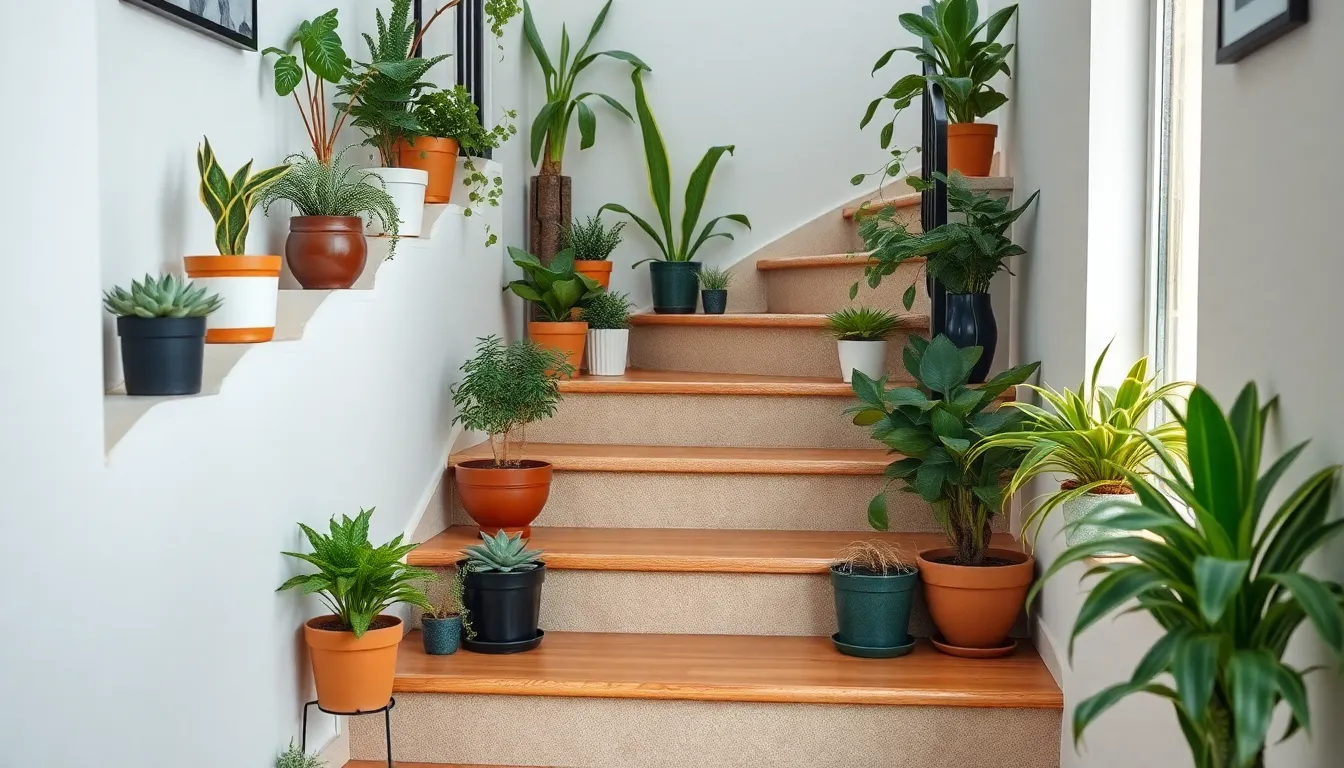
Safety remains paramount when we transform our indoor staircases into botanical showcases. We must never compromise clear pathways for aesthetic appeal when positioning plants throughout our stairwell spaces.
Keep Main Traffic Areas Clear
Evaluate your stair width and foot traffic volume before positioning any plants in your staircase area. We recommend leaving ample space on each step and landing to ensure comfortable passage for all household members. Plants should never encroach on the main traffic flow since blocked pathways significantly increase fall risks.
Position plants adjacent to stairs rather than directly on the steps themselves. This approach prevents tripping hazards while maintaining clear visibility for anyone using the staircase. We can use wall space, corners, and landing edges to display our greenery without creating safety concerns.
Create designated plant zones that don’t interfere with natural walking patterns. Traffic flow analysis helps us identify safe placement areas where plants can thrive without becoming obstacles. We should always prioritize unobstructed movement over decorative placement when space becomes limited.
Secure All Containers Properly
Ensure all plant containers remain stable and cannot be easily knocked over, especially on landings or near edges. Unstable pots pose serious safety risks in high traffic areas like staircases. We must use sturdy containers that can withstand accidental bumps from passing household members or pets.
Secure hanging plants thoroughly to prevent accidents caused by falling containers. Wall mounted systems and ceiling hooks require proper installation with appropriate hardware for the container weight. We should inspect mounting points regularly to ensure they remain secure over time.
Select weighted pots or add stabilizing materials to prevent tipping incidents. Bottom heavy containers with added stones or sand provide excellent stability for floor placed plants near stairways. We can combine lightweight decorative pots with heavier inner containers for both safety and style.
Choose Plants That Won’t Overgrow Pathways
Select compact or slow growing plants that don’t spread into walking areas over time. Succulents like aloe vera work perfectly for stairway environments since they tolerate partial shade and require minimal maintenance. We should avoid species known for rapid expansion that might encroach on pathways.
Avoid large or fast growing foliage that may block sightlines or create pathway obstructions. Plants with spreading habits can quickly transform from decorative elements into safety hazards. We must choose varieties that maintain their compact form throughout their growth cycle.
Monitor plant growth regularly and trim back any foliage extending into traffic areas. Even well chosen plants may occasionally require pruning to maintain safe clearances. We should establish routine maintenance schedules to keep our stairway plants properly contained within their designated spaces.
Water and Care for Your Staircase Plants Effectively
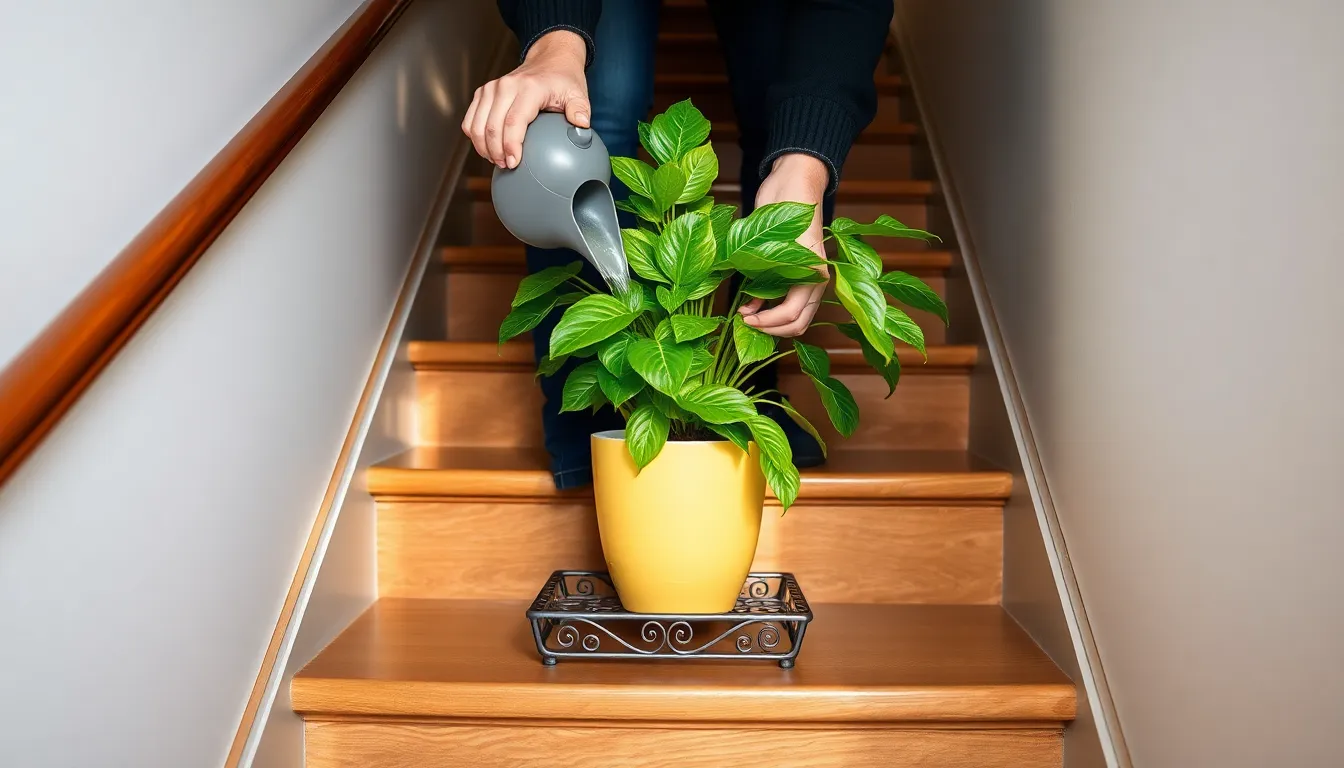
Proper watering and maintenance ensure our staircase plants thrive while protecting our home’s surfaces and safety.
Establish a Regular Watering Schedule
We need to monitor each plant’s moisture needs based on its exact species requirements. Allowing soil to dry slightly between waterings prevents root rot and fungal growth that can damage our plants. Plants positioned on stairs require extra attention since overwatering creates slipping hazards and potential water damage to surrounding surfaces.
Checking our plants regularly helps us identify watering issues before they become serious problems. Yellowing leaves often indicate watering imbalances that we can correct by adjusting our schedule. Using pots with drainage holes allows excess water to escape, which becomes critical when we’re growing plants in elevated stair locations where water runoff poses safety risks.
Use Drip Trays to Protect Flooring
Placing drip trays beneath all our stair plants protects wood, carpet, and tile surfaces from water stains and moisture damage. We should choose trays large enough to catch all water runoff while complementing our staircase design. Cleaning these trays regularly prevents mold and bacteria buildup that could affect both our plants and indoor air quality.
Strategic placement of drip trays becomes especially important on carpeted stairs where water damage can be permanent. Our flooring investment deserves protection through this simple preventive measure. Selecting decorative trays that match our stair aesthetic ensures functionality doesn’t compromise our design vision.
Prune Plants to Maintain Shape and Size
Regular pruning keeps our staircase plants tidy and prevents overgrowth that could obstruct safe passage. We must trim loose vines, extending branches, and oversized leaves that grow into walking spaces to maintain clear stair access. Removing dead or damaged foliage encourages healthy new growth while preventing our plants from becoming trip hazards.
Confined vertical spaces like staircases benefit from consistent pruning that promotes compact, controlled growth patterns. Our pruning schedule should align with each plant’s growth rate and natural shape. Maintaining proper plant size ensures our botanical display enhances rather than compromises stair functionality and safety.
Troubleshoot Common Issues With Indoor Stair Plants
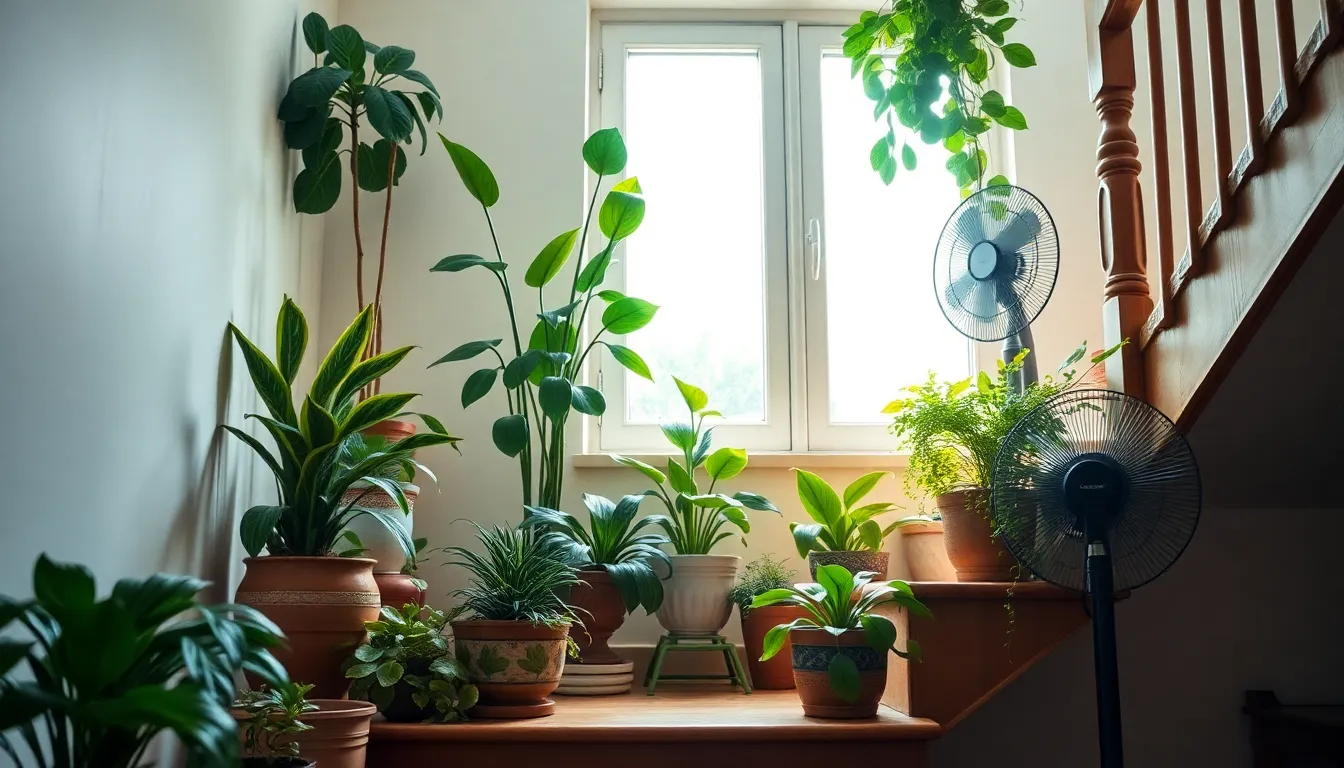
Even the most carefully planned stair gardens can face challenges that affect plant health and appearance. We’ll help you identify and solve the most common problems that arise when growing plants in stairwell environments.
Address Poor Air Circulation Problems
Stagnant air in enclosed stairways creates stress for most indoor plants and reduces their ability to process carbon dioxide effectively. We recommend spacing plants at least 12 inches apart to allow natural airflow around each specimen’s foliage.
Installing a small oscillating fan can dramatically improve air movement without creating harsh drafts that damage delicate leaves. Position the fan to create gentle circulation rather than direct airflow on your plants.
Choose plants that naturally tolerate lower airflow conditions when air circulation remains limited. Snake plants and pothos varieties thrive in these environments because they’ve adapted to process air efficiently even in confined spaces.
Monitor your plants for signs of poor circulation like yellowing leaves or increased pest problems. These symptoms often indicate insufficient air movement around your stairway garden.
Manage Dust Accumulation on Leaves
Dust buildup blocks the tiny pores called stomata on plant leaves, reducing their photosynthesis capacity by up to 50% according to indoor plant research. We suggest cleaning smooth leaves weekly with a soft, damp microfiber cloth to maintain optimal plant function.
Use a soft-bristled brush for plants with fuzzy or textured leaves like African violets or begonias. Water droplets can become trapped in these leaf surfaces and create fungal problems if you use cloth cleaning methods.
Avoid commercial leaf shine products entirely as they clog leaf pores and create an artificial barrier that prevents normal plant respiration. Natural cleaning with plain water maintains the leaf’s ability to exchange gases properly.
Establish a rotating cleaning schedule where you clean one section of your stair plants each week. This approach keeps all plants healthy without overwhelming your maintenance routine.
Handle Temperature Fluctuations
Stairways experience frequent temperature changes due to opening doors, foot traffic, and varying heat distribution throughout the vertical space. We recommend placing plants away from direct sources of drafts like doorways or HVAC vents that create sudden temperature shifts.
Select plants that tolerate temperature variations of 10-15 degrees Fahrenheit without stress. ZZ plants and most palm varieties handle these fluctuations better than sensitive tropical species that require stable conditions.
Position a thermometer at different stair levels to track temperature patterns throughout your stairway. Upper stairs typically stay warmer while lower areas remain cooler due to natural heat circulation patterns.
Create microclimates using plant groupings that help moderate temperature swings for more sensitive species. Larger plants can shelter smaller ones from drafts while still allowing adequate light penetration.
Conclusion
We’ve explored how plants can transform our indoor staircases from ordinary passageways into breathtaking vertical gardens that enhance our homes’ beauty and air quality. By following proper placement strategies and selecting the right varieties for different light conditions we’ll create stunning displays that thrive in stairwell environments.
The key to success lies in balancing aesthetics with safety while maintaining consistent care routines. With thoughtful container selection strategic lighting answers and regular maintenance our stair gardens will flourish year-round.
Start small with one or two low-maintenance plants and gradually build your collection as you gain confidence. Your indoor staircase has incredible potential to become a living masterpiece that welcomes guests and brings joy to your daily routine.
Frequently Asked Questions
What are the best plants for staircase decoration?
Snake plants, pothos, and ZZ plants are ideal for staircases. Snake plants require minimal maintenance and purify air, pothos create beautiful trailing effects with their cascading vines, and ZZ plants thrive in extremely low light conditions. These varieties can handle the unique lighting and space constraints typically found in stairwell environments.
How do I choose the right lighting for staircase plants?
Install LED grow lights in darker stairwells to provide full-spectrum lighting without heat buildup. Use LED strips along railings for consistent illumination and timer controls for regular schedules. Maximize natural light by positioning plants near windows in indirect light and using mirrors to reflect and amplify available light throughout the space.
What containers work best for stair plant displays?
Wall-mounted planters save floor space and work well for narrow staircases. Use weighted pots with drainage systems to prevent tipping and water damage. Wrought iron plant stands elevate containers safely while adding architectural interest. Hanging baskets utilize overhead space effectively, creating cascading displays that enhance visual appeal without blocking traffic flow.
How do I arrange plants on stairs for maximum visual impact?
Create visual rhythm by repeating similar plants at regular intervals. Use different plant heights to add layers and dimension through tiered planters. Focus on landing areas for larger statement plants that anchor the display. Position plants strategically to draw the eye upward while maintaining clear traffic paths for safety.
What safety considerations should I keep in mind?
Keep main traffic areas completely clear and position plants away from walkways to prevent tripping hazards. Use weighted, stable containers to prevent tipping. Install secure mounting for wall planters and hanging baskets. Ensure proper drainage with drip trays to prevent slippery surfaces and protect flooring from water damage.
How often should I water staircase plants?
Establish a regular watering schedule based on each plant’s specific needs. Check soil moisture weekly and water when the top inch feels dry. Use drip trays under all containers to protect flooring and prevent slip hazards. Consider that stairwell plants may need less frequent watering due to lower light conditions and reduced evaporation.
How do I deal with poor air circulation around stair plants?
Space plants adequately to improve natural airflow between containers. Use small oscillating fans to enhance circulation, especially in enclosed stairwells. Select plant varieties that tolerate lower airflow conditions, such as snake plants and ZZ plants. Avoid overcrowding plants in corners or against walls where air movement is most restricted.
What should I do about dust accumulation on stair plants?
Clean plant leaves regularly using a damp cloth or gentle spray bottle with water. For larger plants, use a soft brush to remove dust buildup. Avoid commercial leaf shine products that can clog plant pores. Regular cleaning not only improves appearance but also helps plants photosynthesize more effectively in already limited light conditions.

